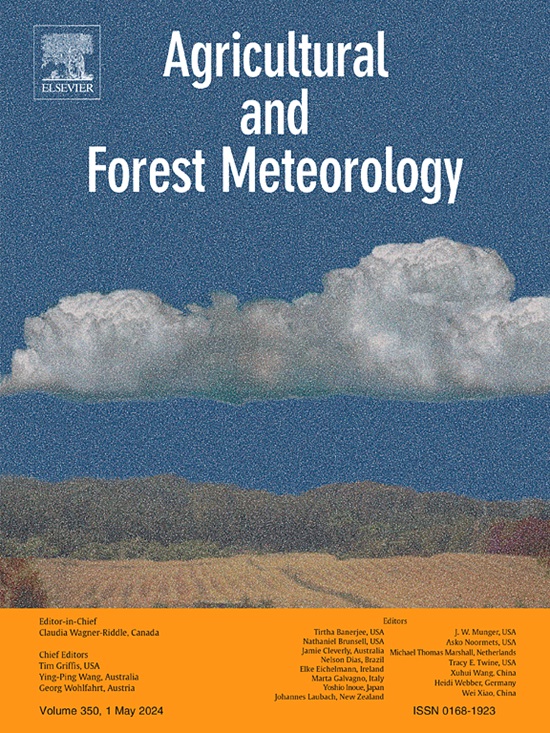Evaluation of a novel approach to partitioning respiration and photosynthesis using eddy covariance, wavelets and conditional sampling
IF 5.6
1区 农林科学
Q1 AGRONOMY
引用次数: 0
Abstract
The eddy covariance (EC) technique remains a cornerstone for direct, continuous monitoring of greenhouse gases fluxes, particularly for carbon dioxide (CO2). Traditionally, EC-derived net ecosystem exchange (NEE) is partitioned into gross primary productivity (GPP) and ecosystem respiration (Reco) using model-based approaches. Here, we present a novel, fully empirical partitioning method that applies conditional sampling to wavelet-decomposed signals, isolating positive and negative contributions of the wavelet co-spectrum of vertical wind velocity and CO₂ dry molar fraction, conditioned by the water vapour flux. This method was evaluated across two French ICOS sites, a mixed forest (FR-Fon) and a cropland (FR-Gri), over multiple years.
The approach is grounded in the hypothesis that wavelet decomposition enables separation of oppositely signed turbulent structures across scales, a claim supported by co-spectral analysis. The resulting flux components exhibited distinct frequency signatures under neutral and unstable atmospheric conditions, though not under stable stratification.
Daily partitioned fluxes derived from this method aligned well with GPP and Reco estimates from established nighttime- and daytime-based partitioning, with inter-method differences smaller than those observed between the conventional approaches themselves. Conceptually the method approximates net photosynthesis and offered improved coherence with site-specific ecological and management dynamics, capturing events such as growing season, harvest, and manure application at FR-Gri, more reliably than standard methods. It also avoided spurious GPP estimates common error in the night-time approach. Moreover, the diel Reco cycle revealed a bimodal pattern, suggestive of combined influences from solar radiation and soil temperature, in contrast to the predominantly single temperature-driven dynamics inferred by conventional models.
Our findings demonstrate that wavelet-based conditional sampling offers a promising alternative for CO2 flux partitioning, one that is entirely empirical, calibration-free, and grounded in the physical co-emission dynamics and transport from surface to the atmosphere.
一种利用涡流相关、小波和条件采样来划分呼吸和光合作用的新方法的评价
涡旋相关方差(EC)技术仍然是直接、连续监测温室气体通量,特别是二氧化碳通量的基础。传统上,生态系统净交换(NEE)利用基于模型的方法被划分为总初级生产力(GPP)和生态系统呼吸(Reco)。在这里,我们提出了一种新颖的、完全经验的划分方法,该方法将条件采样应用于小波分解信号,分离出垂直风速和CO₂干摩尔分数的小波共谱的正贡献和负贡献,这些贡献由水蒸气通量决定。该方法在两个法国ICOS站点进行了多年的评估,一个混交林(FR-Fon)和一个农田(FR-Gri)。该方法基于小波分解能够跨尺度分离相反签名的湍流结构的假设,这一主张得到了共谱分析的支持。所得通量分量在中性和不稳定大气条件下表现出明显的频率特征,而在稳定分层下则没有。该方法得出的每日划分通量与基于夜间和日间划分的GPP和Reco估算值很好地吻合,方法之间的差异小于传统方法之间观察到的差异。从概念上讲,该方法近似于净光合作用,并与特定地点的生态和管理动态提供了更好的一致性,比标准方法更可靠地捕捉诸如FR-Gri的生长季节、收获和肥料施用等事件。它还避免了夜间方法中常见的虚假GPP估计错误。此外,diel Reco周期显示出双峰模式,表明太阳辐射和土壤温度的综合影响,而不是传统模式推断的主要单一温度驱动的动态。我们的研究结果表明,基于小波的条件采样为CO2通量分配提供了一个很有前途的替代方案,它完全是经验的,无需校准的,并且基于物理共排放动力学和从地表到大气的传输。
本文章由计算机程序翻译,如有差异,请以英文原文为准。
求助全文
约1分钟内获得全文
求助全文
来源期刊
CiteScore
10.30
自引率
9.70%
发文量
415
审稿时长
69 days
期刊介绍:
Agricultural and Forest Meteorology is an international journal for the publication of original articles and reviews on the inter-relationship between meteorology, agriculture, forestry, and natural ecosystems. Emphasis is on basic and applied scientific research relevant to practical problems in the field of plant and soil sciences, ecology and biogeochemistry as affected by weather as well as climate variability and change. Theoretical models should be tested against experimental data. Articles must appeal to an international audience. Special issues devoted to single topics are also published.
Typical topics include canopy micrometeorology (e.g. canopy radiation transfer, turbulence near the ground, evapotranspiration, energy balance, fluxes of trace gases), micrometeorological instrumentation (e.g., sensors for trace gases, flux measurement instruments, radiation measurement techniques), aerobiology (e.g. the dispersion of pollen, spores, insects and pesticides), biometeorology (e.g. the effect of weather and climate on plant distribution, crop yield, water-use efficiency, and plant phenology), forest-fire/weather interactions, and feedbacks from vegetation to weather and the climate system.

 求助内容:
求助内容: 应助结果提醒方式:
应助结果提醒方式:


